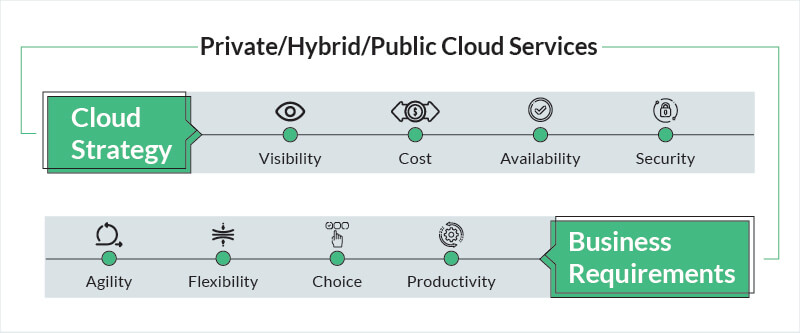It is that day. When you have decided to adopt the cloud in all its glory. The decision is made, and you are all ready to embrace its potential to the fullest. But getting on the cloud bandwagon is not an easy goal. Not many people associate F1 with a ‘strategy’. But even for a seemingly one-man-sport, there is a team strategy involved that is followed not just by the driver, but the entire pit crew and the engineers as well. And sometimes it is this strategy that makes all the difference between the top spot and no spot. Cloud adoption is something similar. However, it is not a race, but a journey that has no checkered flag at the end, simply because there is no ‘end’ per se. It is a continual path of digital transformation an enterprise embarks on, and excellence is honed along the way.
In matters of cloud adoption, the tough part is to ensure the path, the platform, and the partner are all aligned with your business objectives and that the journey can be undertaken with the least disruption and ballooning of costs. If these issues are not addressed upfront, it can end up wasting a tremendous amount of resources like money, time, and last but not the least, opportunities.
So, What Exactly is a Cloud Strategy?
It’s no surprise that in an ever-changing business environment, it is imperative for enterprises to respond to the dynamics with agility, resilience, and security. Amidst the chaos, it is also the enterprise’s responsibility to spot and seize opportunities and outperform the competition. It is in this context that cloud services play a key role with the right deployment of the right strategy to eliminate your IT or operational expenditure to the maximum extent and enables you to achieve greater cost benefit, and business agility through modern cloud-native architecture to scale as per business demands and realize faster time-to-market. In short: anticipate, plan, and execute.

The Importance of Cloud Strategy
When it comes to cloud adoption, there is no such thing as one-size-fits-all. A successful cloud deployment needs a clear strategy that gives an expert-generated comprehensive digital maturity evaluation of your current IT systems or on-premises environment. A successful implementation is beneficial in more ways than one.
Unlocking innovation and scalability: With the cloud as an infrastructure base for innovation, enterprises can enjoy improved performance, lowered costs, and increased agility and freedom to scale on demand.
Cost reduction: Probably the most important edge, cloud services provide a cost advantage over on-premises data centers, by taking advantage of cloud pay-as-you-go services, paying only for the services that you have used, and having the possibility to optimize workloads to make them function more efficiently at a lower cost. Migrating to the cloud can help organizations of all sizes to reduce costs and improve IT productivity. According to Microsoft Office 365, 82% of the companies surveyed reduced costs by migrating to the cloud.
The 8-step Approach for Formulating a Cloud Strategy
Creating a cloud strategy involves 8 steps – each touching upon various perspectives and objectives, both from technical and business viewpoints, with end goals in mind. The steps are:
1. Analysing business objectives
The first step is the most important one: defining the business objective. This exercise should help you match these with what you aim to achieve from the cloud. Ideally, the cloud should meet the SMART framework: specific in technologies and platforms, measurable in progress, agreed mutually, realistic in terms of vision, and time-bound when it comes to execution.
2. Align with a vision
Next, you need to ensure that every IT architecture goal is in perfect sync with business initiatives and visions that span longer time frames. A cloud strategy is not for a few quarters but is more suited for years to come. Over this period, milestones can be set and achieved, and progress analysed for any required course correction.
3. Articulation of strategic goals
From a technology perspective, most cloud services of today are great solutions for business challenges or problems that hinder innovation, growth, and streamlining. When considering a digital infrastructure for tomorrow, articulation of current and future goals helps keep a keen eye on things as they move on. These goals could be regarding business models, operational excellence, customer centricity, enhancing decision-making process, competitive advantage, or business continuity.
4. Examining business capabilities vis-à-vis cloud adoption
Like stated earlier, it all begins with a vision. A vision that is not obscured by pre-conceived notions about what is and what it should be. For an enterprise to realize the maximum potential of the cloud, every facet, from IT systems to different business functions has to be considered. These could be both tangible like IT assets, and intangible – like people power and HR policies. Mapping these in context with the cloud is equally fundamental and can become a North Star for the course to steer in the future.
5. Current business contextualization
As seen inside-out, an enterprise can look at a 360-degree view of the environment of its operations and what challenges abound for it to widen its horizons. Current becomes the ‘now’. And with the help of the cloud, the direction to take becomes the ‘next’. It is how you move from the ‘now’ to the ‘next’ will become the strategy’s navigation chart. Exercises like brainstorming, design thinking, PESTEL frameworks etc. are great tools to deploy at this stage.
6. Assessing the as-is IT architecture
A holistic cloud strategy takes into consideration how IT assets augment business objectives as well as identifying the existing gaps. To analyse this and how moving from legacy architecture to the cloud needs its own level of technical maturity that goes above and beyond the usual. Only then a cloud implementation can be par excellence.
7. Moving towards a target state
How will the enterprise behave when it is fully enabled with a cloud architecture? What will its impact be on everyday business processes and operations? How will security get impacted? Will there be any disruption? These are the questions that need to be answered for reaching the target state seamlessly and securely. Technical considerations like authentication, identification, confidentiality, and auditability are of paramount importance. Risk analysis and fit-gap analysis come to the fore here as well.
8. Implementation scheduling with prioritization
Even the best strategy on paper is no strategy at all, unless it is implemented exactly as envisioned. Towards this, an implementation roadmap with scheduling and milestone marking is critical. Despite the best-laid plans, it is not surprising that even midway, unforeseen circumstances may beget the need for re-evaluating dependencies, costs, etc., and newer recommendations coming into the picture. Prioritization is a great way to go about implementing the overall plan, since rushing things is never a good idea for an undertaking as complex as cloud adoption.
Develop a Cloud Strategy with Hexaware
It goes to say, the need for having the right cloud partner by your side is a good strategy in itself. As cloud strategic partnerships gain more prominence, it becomes imperative to contract a partner who can help build a strong foundation to facilitate digital transformation, operational excellence, and bring forth cutting-edge products and services. For this, the partner has to be on the same page as your business objectives. Using that as a starting point, the journey should then be laid out in the most grounded way possible – including addressable market and monetization models, engineering capability, and platform marketing. A partner that best balances these factors will help enable a broader ecosystem that births more comprehensive customer solutions, and the potential for greater innovation and growth. But there’s more one factor that is absolutely essential that a cloud partner has to deliver: acceleration.
At Hexaware, we have an industry-proven record in fast-tracking cloud migration strategy that also accelerates the overall journey. At the core of this strategy is re-imaging customer experiences with transformative cloud solutions. Hexaware’s amaze® is designed not just for accelerated cloud migration but also to enable needed business agility while bringing together the best of the cloud benefits you seek. With amaze® you can ignite your business ambitions for now and the future. For more information on knowing how Hexaware can be the right cloud strategy partner you need, please visit https://hexaware.com/services/cloud-transformation/



















